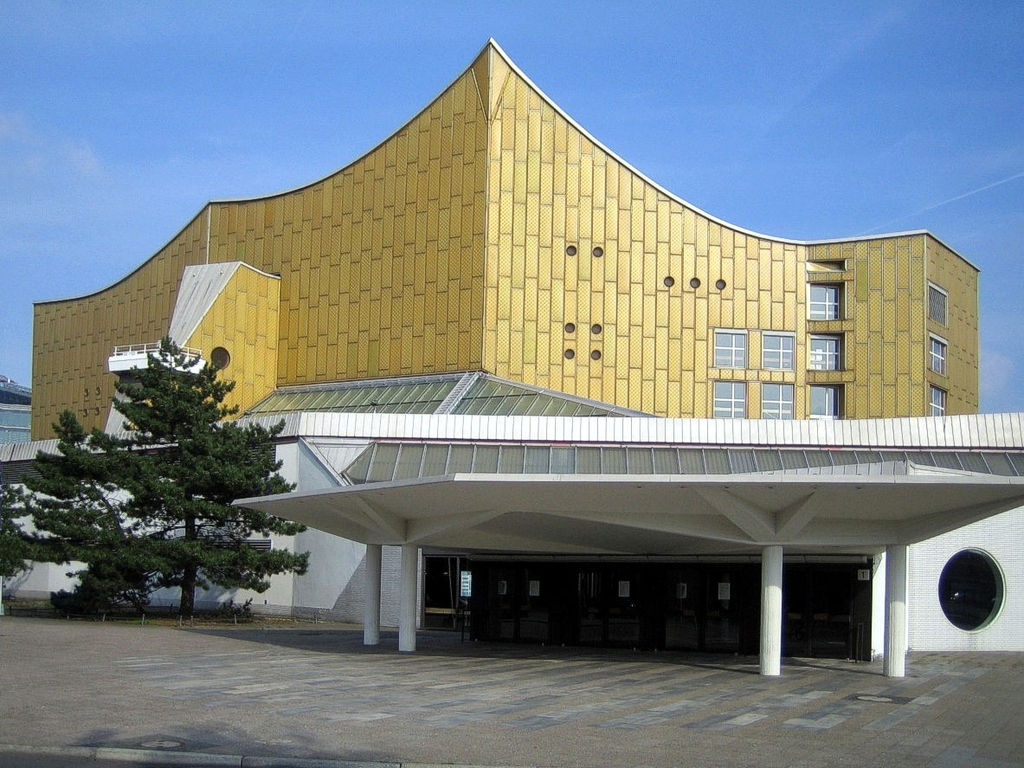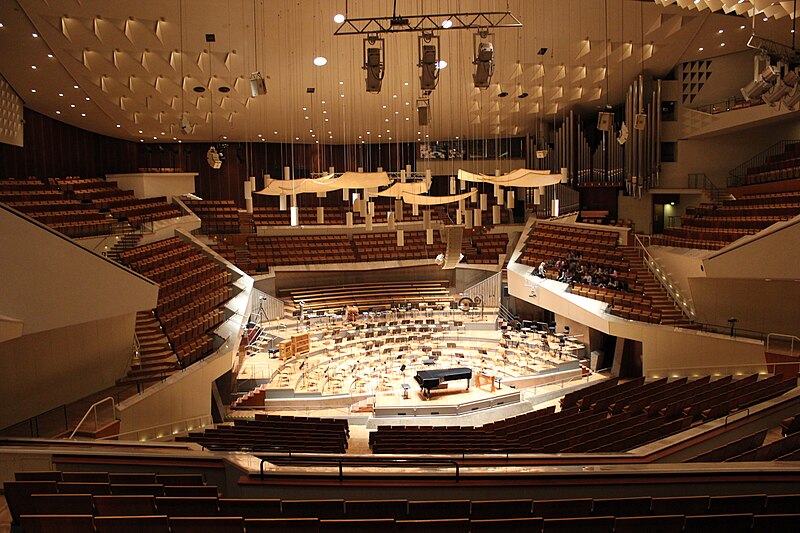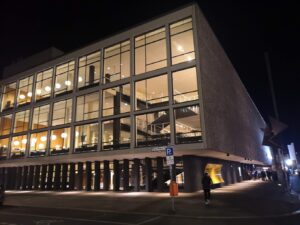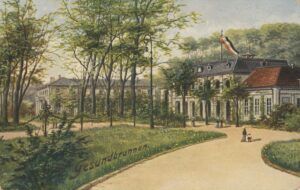The Berliner Philharmonie, at Herbert-von-Karajan-Straße 1, is one of the world’s great concert halls. Loathed by some, loved by others, its bold modernist design marks a deliberate break with the architectural tradition of the buildings in this area, not far from the Brandenburg Gate.

Yet this celebrated cultural landmark occupies ground heavy with a particularly dark history. Here, in the late 1930s and early 1940s, in an otherwise normal residential building, stood the headquarters of the Third Reich’s secret T4 euthanasia program, where the systematic murder of disabled people was planned and directed. The post-war decision to build a home for one of the world’s greatest orchestras on this site starkly reflects Berlin’s complex relationship with its past as few other places do. This transformation, from a place of horrific crime to a place of transcendent musical beauty, is the story of Berlin. It might very well be the story of humanity in all our infinity, and occasionally terrible, complexity.
The Current Building
The story of the building you see today begins in the Cold War. The T4 building had been badly hit in the war and the ruins torn down, creating a barren site which was subsequently put to altogether much better uses. Designed by architect Hans Scharoun and completed in 1963, the Philharmonie has a striking yellow exterior and asymmetrical pentagonal shape which marked a radical departure from traditional concert hall design. Here lies the origin of that knee-jerk «loath it or love it» reaction that I mentioned. Yet for all that its exterior is eye-catchingly different, its most revolutionary feature lies inside: the main concert hall’s «vineyard» style arrangement places the orchestra at the center, with the audience seated in irregularly terraced blocks that surround the stage on all sides. This design not only creates exceptional acoustics but also embodies democratic ideals by eliminating the traditional hierarchy of seating arrangements.

And that expression of democratic ideals was highly symbolic in the depths of the Cold War, with the authoritarian East Germany state border lying mere blocks away.
The building’s location in what was then West Berlin, just south of the Tiergarten, positioned it as a cultural stronghold during the Cold War. The Berlin Wall divided the city, creating a unique dynamic between the Berliner Philharmonie and its East German counterpart, the Konzerthaus Berlin (formerly Schauspielhaus) on Gendarmenmarkt. While the Konzerthaus maintained the classical traditions of East German cultural politics, the Philharmonie became a symbol of Western modernism and artistic freedom.
The relationship between East and West Berlin’s musical institutions reflected the larger cultural divide of the Cold War. While the Berlin Philharmonic in the West attracted international audiences and pushed musical boundaries, the East Berlin Symphony Orchestra maintained a more traditional repertoire in an altogether more traditional building.
This might seem odd in a state founded on revolutionary principles. But certainly by the late 60s, the Communist leaders were pushing hard to promote East Germany as the heartland of «the Real Germany,» as opposed to the upstart illegitimate creation that was West Germany. So for all its revolutionary aspects, there was a cross-current of traditionalism that cut through East German society. This tension within East Germany, and against West Germany, would persist until reunification in 1990, after which both institutions would begin a gradual process of redefining their roles in a unified Berlin.
The Philharmonie has today become an integral part of the Kulturforum, a collection of cultural buildings that includes the New National Gallery and the State Library. This cultural complex, developed in West Berlin as a counterpoint to the Museum Island in the East, represents the city’s post-war commitment to rebuilding through culture. Today, in unified Berlin, both the Philharmonie and the Konzerthaus thrive, their former rivalry transformed into a rich musical dialogue that enriches the city’s cultural landscape.
The Orchestra
The history of the Berlin Philharmonic itself is inextricably linked with Germany’s turbulent 20th century. Under Arthur Nikisch’s leadership from 1895, the orchestra established itself as one of the world’s premier musical ensembles. His successor in 1923, Wilhelm Furtwängler, would guide the orchestra through its most controversial period. Despite his personal opposition to the Nazi regime, Furtwängler’s decision to remain in Germany and continue periodically conducting during the Third Reich would haunt his legacy. A particularly contentious moment came on April 20, 1942, when he conducted Beethoven’s Ninth Symphony for Hitler’s birthday, after which Joseph Goebbels approached the podium to shake his hand – an image that would become emblematic of the complex relationship between art and politics during the Nazi era.
The orchestra’s journey through the war years was marked by an almost nomadic existence, forced to adapt as their performance spaces fell victim to the bombing campaigns. Their original home, established in 1882, had begun life as a simple skating rink on Bernburger Straße in Kreuzberg. Architect Franz Schwechten had transformed this humble structure into the first Philharmonie, while a more intimate venue, the Beethovensaal on Köthener Straße, opened in 1899 to host chamber music performances. These beloved halls witnessed decades of musical triumphs until the war brought devastation. On January 30, 1944 – eleven years to the day after Hitler’s rise to power – British bombs reduced the original Philharmonie to rubble. The orchestra found temporary refuge in the Staatsoper Unter den Linden, only to see this grand opera house badly damaged by bombs on February 3, 1945. In these final desperate months, the musicians also performed in the Titania-Palast, now a movie theater, that would serve as their primary venue through the immediate post-war years, while the Beethovensaal continued to host smaller concerts.
The orchestra’s wartime history reached its dramatic climax in the spring of 1945. After Furtwängler fled to Switzerland to escape the Gestapo in January, Leo Borchard took up the baton. The final concert before the Battle of Berlin, on April 12, 1945, featured Wagner’s Götterdämmerung, including Brünnhilde’s Immolation Scene – a darkly appropriate choice as Hitler Youth members reportedly distributed cyanide pills to audience members who wished to escape the advancing Red Army. The Nazi’s dark sense of the theatrical lasted to the very end.
VISITING THE BERLINER PHILHARMONIE
Location and Access
The Philharmonie is located at Herbert-von-Karajan-Straße 1, 10785 Berlin. The venue is easily accessible via public transportation: The nearest U-Bahn station is Potsdamer Platz (U2 line), and several bus lines stop nearby. For those arriving by car, there is an underground parking garage beneath the Kulturforum.
Guided Tours
The Philharmonie offers guided tours that allow visitors to explore the architecture and learn about the building’s history. The foyer is open to the public during the day, offering a chance to view its impressive architecture even without a concert ticket.
Tickets and Dress Code
The Berlin Philharmonic’s ticket office is in the main foyer. Tickets can be purchased in person, but I recommend booking in advance for popular times and performances.
While there is no strict dress code, some attendees opt for smart casual or even formal attire for evening performances, but really practically anything goes. It’s Berlin, after all!
If you can’t attend in person, the Berlin Philharmonic pioneered the Digital Concert Hall, a platform that streams concerts live and provides access to an extensive archive of performances.
For current ticket prices, tour schedules, and concert programs, visitors should consult the Berlin Philharmonic’s official website as these details are obviously constantly changing and evolving.





